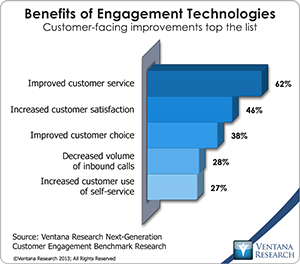In my research of NICE Systems for several years I have remarked often that its biggest challenge is to integrate all the products that now make up its Customer Interaction Management suite. Through acquisitions, in-house development and partnerships, this suite has grown to include interaction recording, quality management, workforce management, incentive management, interaction analytics, performance management, real-time guidance, customer feedback management, mobile access and Web-based customer service.
In my research of NICE Systems for several years I have remarked often that its biggest challenge is to integrate all the products that now make up its Customer Interaction Management suite. Through acquisitions, in-house development and partnerships, this suite has grown to include interaction recording, quality management, workforce management, incentive management, interaction analytics, performance management, real-time guidance, customer feedback management, mobile access and Web-based customer service. The company still offers each of these applications separately, but increasingly NICE bundles selected products into what it calls “solution suites” for uses such as workforce optimization. It also configures these suites to meet specific business needs such as voice of the customer and operational efficiency. These bundles require integration, common administration and management capabilities, as well as standardization of the user interface. My latest briefing by NICE executives showed the company moving in these directions but still having more to do to meet the expectations of a new generation of users. Successfully integrating applications to become business-related solutions is critical according to our benchmark research into next-generation workforce optimization, in which nearly half (48%) of participants said that integration is very important; analysis show that they want systems to be easier to use, to provide a better user experience, to be less error-prone and to connect processes such as customer feedback and workforce optimization. Version 6 of NICE Customer Interaction Management moves in this direction, with an integrated portal into performance management, workforce management and contact management, unified administration capabilities and enhancements to the user interface.
At the core of the suite are the applications most research participants said are important for the next generation of workforce optimization. The three most often used remain call recording, quality management and workforce management, but we find that coaching is seen as the most likely area of investment (17% plan to invest in such systems in the next 12 to 24 months), and collaboration (currently used by 31% of participants), non-call data capture (29%) and compensation management (28%) all are becoming key systems, which NICE also includes in its interaction suite.
participants said are important for the next generation of workforce optimization. The three most often used remain call recording, quality management and workforce management, but we find that coaching is seen as the most likely area of investment (17% plan to invest in such systems in the next 12 to 24 months), and collaboration (currently used by 31% of participants), non-call data capture (29%) and compensation management (28%) all are becoming key systems, which NICE also includes in its interaction suite.
One area where NICE is focusing now is employee engagement. This is a subject much discussed by consultants and application vendors, based on the assumption that happy agents make happy customers. My benchmark research into the agent desktop and customer service lends weight to this impression by revealing that satisfied agents do deliver business benefits. The research shows that agents very satisfied in their jobs twice as often as satisfied agents improve the key customer-related metrics of customer satisfaction and net promoter scores, and first-contact-resolution rates; the main benefit is that customers receive a better experience. The research also shows the primary factors impacting agent satisfaction: having input on their work schedules, receiving assistance in resolving customer interactions, getting focused and timely training and coaching, working toward incentives that match individual performance and gaining insight into how well they are performing against their targets. NICE’s suite of integrated, broad-based products can address these needs, especially now that it includes gamification techniques to engage employees for better performance.
I’ve said before that I am not keen on the concept of gamification if it means that agents are playing games at work. Learning more about it, however, I admit that used in the right way gamification can enhance employee engagement. We all like being recognized (and rewarded), and the NICE gamification tools provide a fun way to encourage employees to do a good job and reward them when they do so. The basics are simple: Agree on targets (which could be meeting a performance metric, passing a training course or helping on a community project); attach a reward to meeting the targets (which could be cash, increased privileges in selecting work shifts or simply a gold star); show employees their progress toward the targets; and present the rewards for meeting them (whether in private or public recognition such as agent of the month). Behind the fun is a serious way of motivating employees to perform well.
NICE Systems has long been a leading vendor in workforce optimization. However, the means of handling customer interactions are  changing rapidly, with more channels of engagement and more employees across the enterprise getting involved. NICE advanced late in 2013 through acquisition of Causata to gain access to provide smarter customer interactions through real time customer engagement on the Internet. This advancement will help organizations fulfill on the benefits of customer engagement technologies as found in our research with the top two being improving customer services (62%) and increase customer satisfaction (46%). I am convinced that to match customer expectations companies need to be more connected: Achieving that includes better sharing of information, integrated systems, processes that cross business unit boundaries, and better metrics and analysis of performance. NICE is evolving with its market, developing systems and packaged solutions that support companies’ efforts to achieve these objectives. NICE is fulfilling on its milestones communicated in 2013 at their user conference that I already analyzed. I recommend that organizations undertaking such efforts evaluate what NICE has to offer.
changing rapidly, with more channels of engagement and more employees across the enterprise getting involved. NICE advanced late in 2013 through acquisition of Causata to gain access to provide smarter customer interactions through real time customer engagement on the Internet. This advancement will help organizations fulfill on the benefits of customer engagement technologies as found in our research with the top two being improving customer services (62%) and increase customer satisfaction (46%). I am convinced that to match customer expectations companies need to be more connected: Achieving that includes better sharing of information, integrated systems, processes that cross business unit boundaries, and better metrics and analysis of performance. NICE is evolving with its market, developing systems and packaged solutions that support companies’ efforts to achieve these objectives. NICE is fulfilling on its milestones communicated in 2013 at their user conference that I already analyzed. I recommend that organizations undertaking such efforts evaluate what NICE has to offer.







